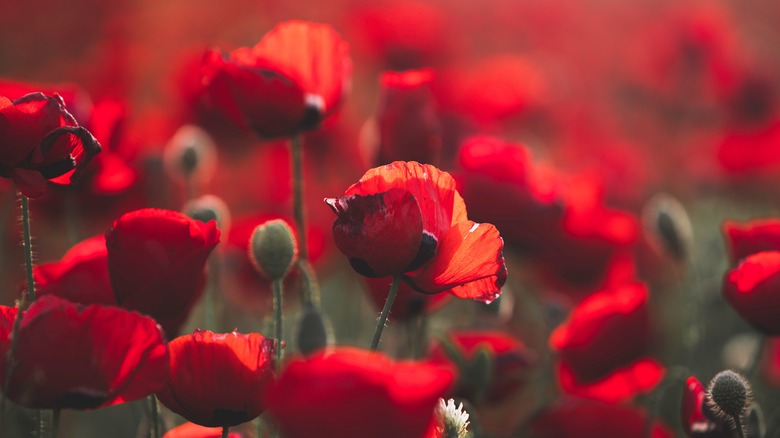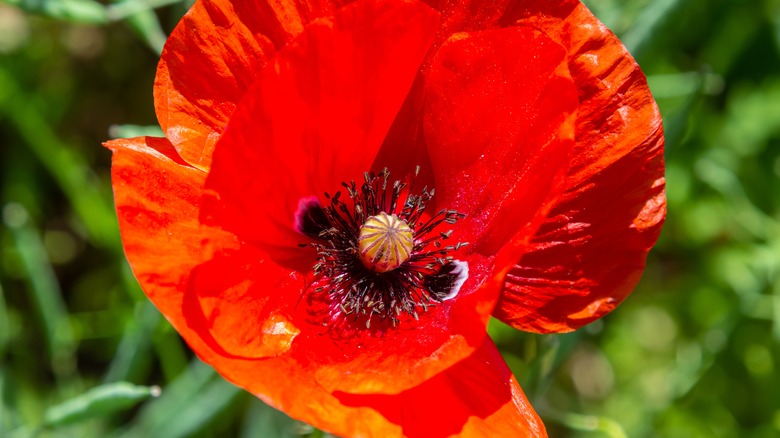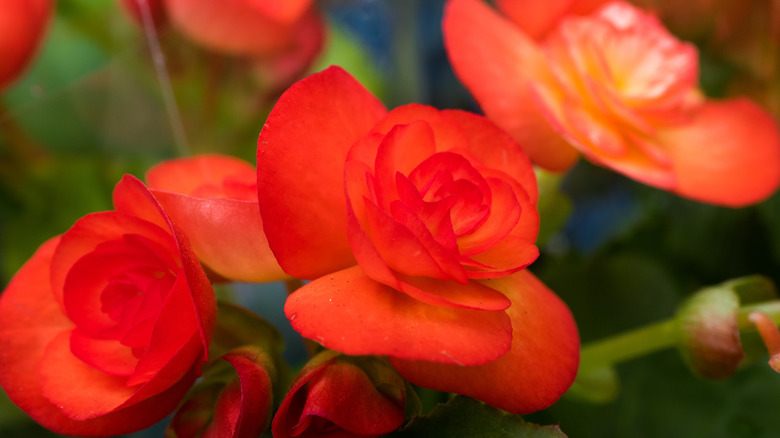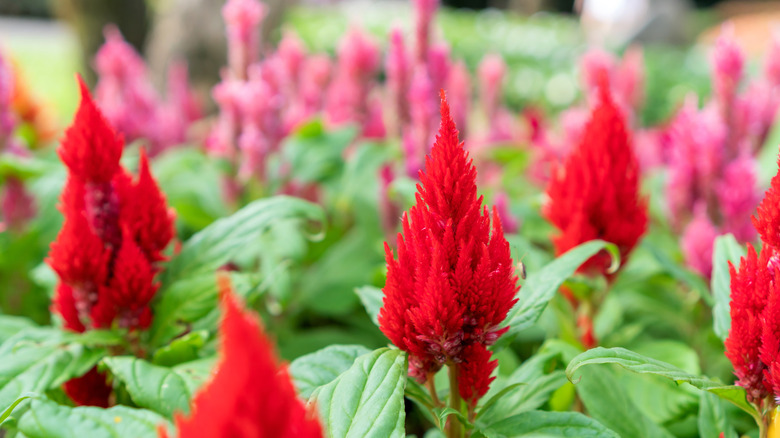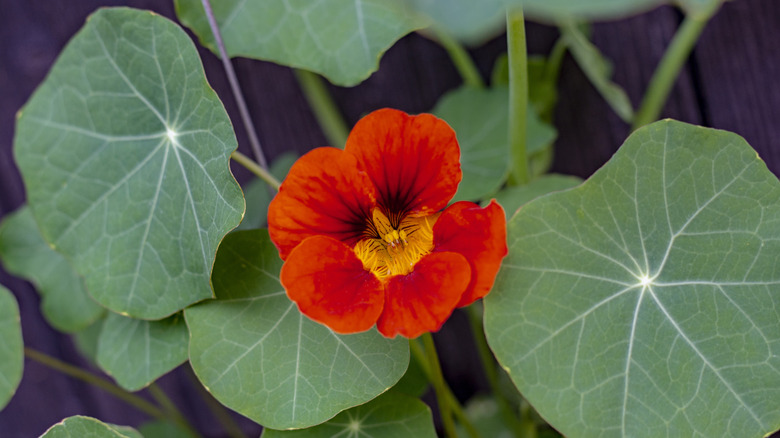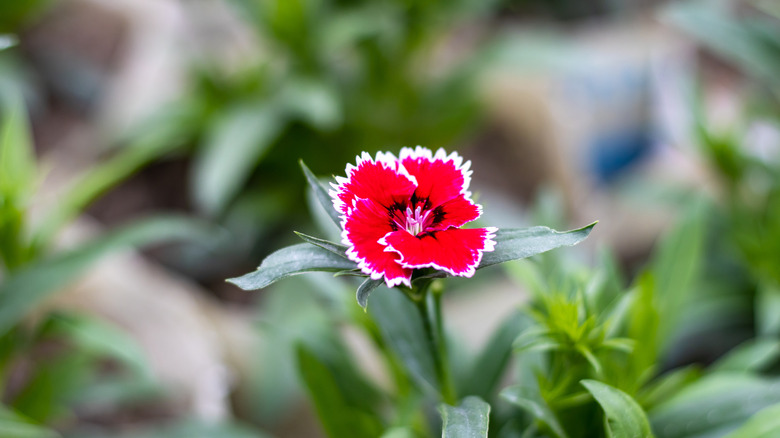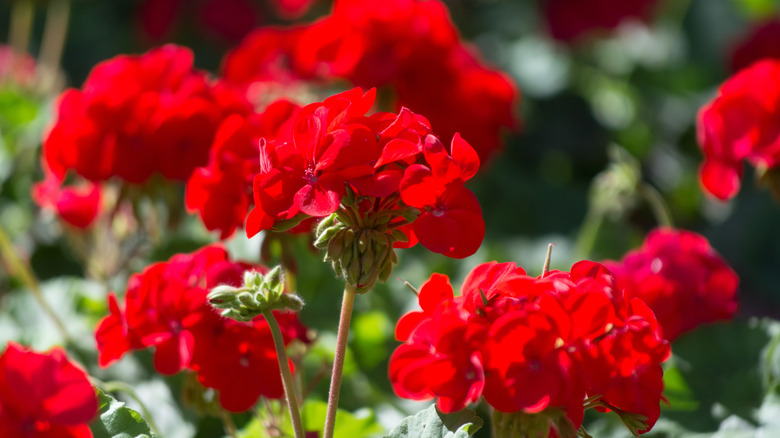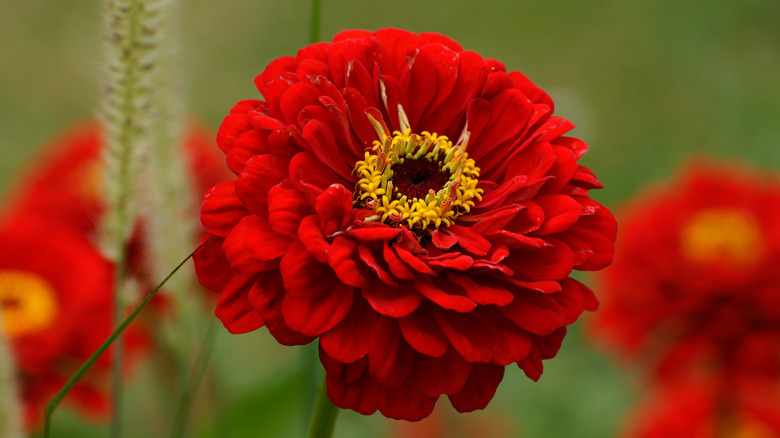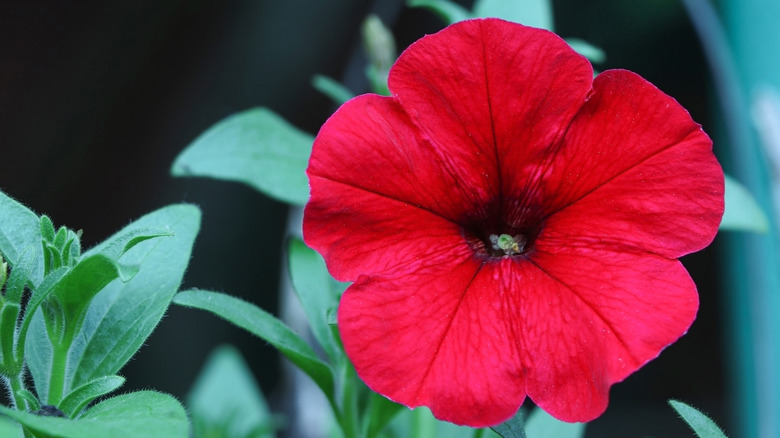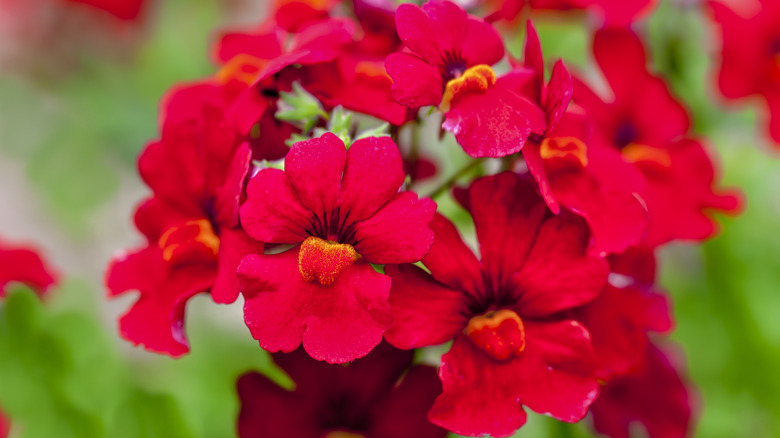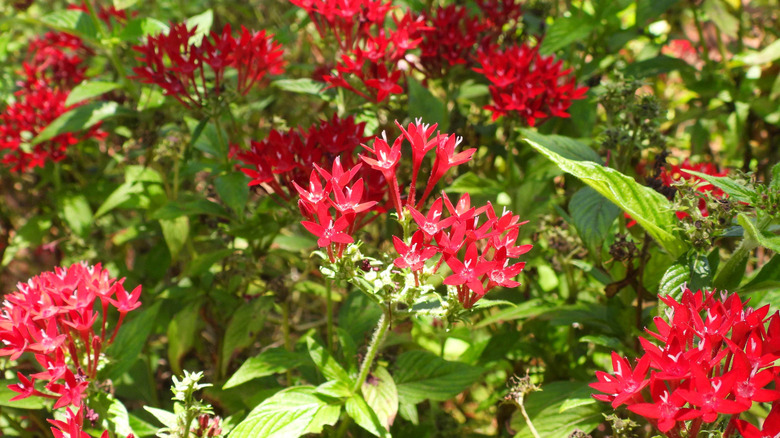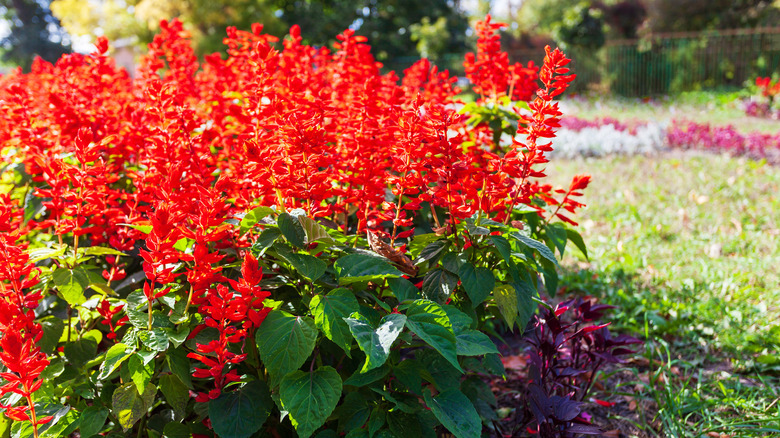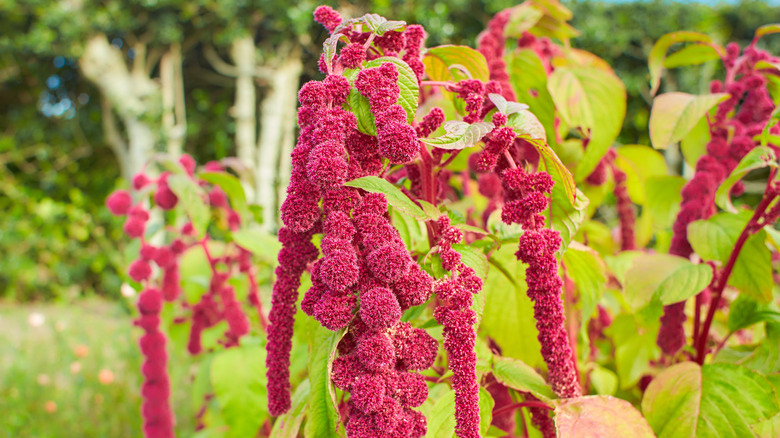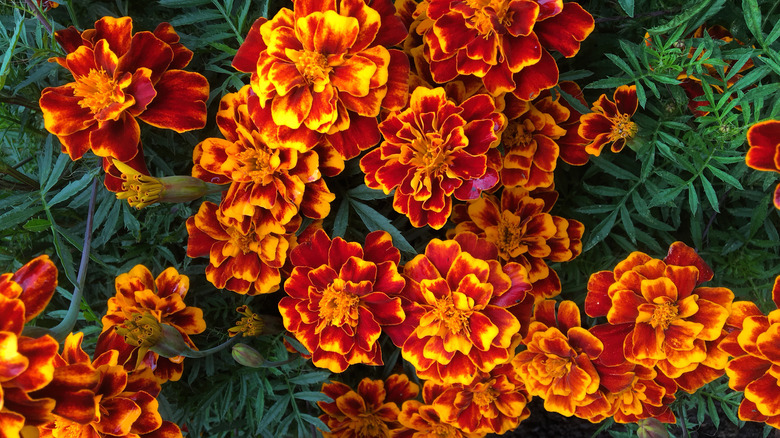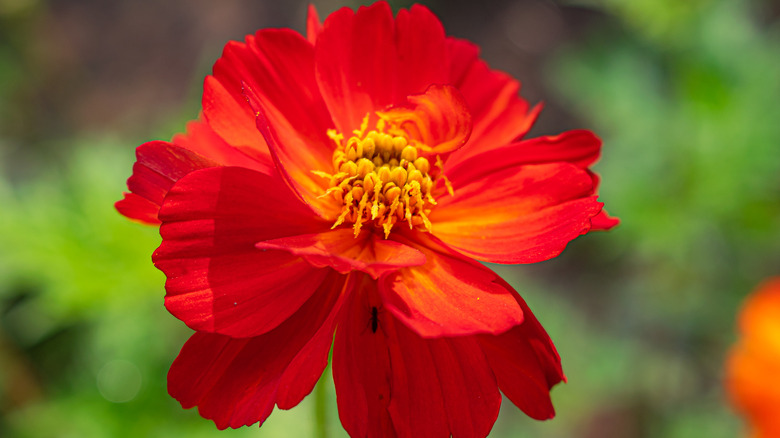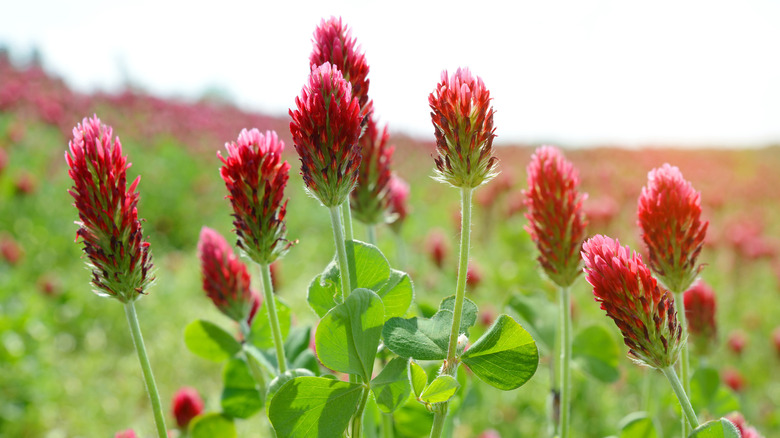15 Annuals That Bloom With Vibrant Red Flowers
Looking for a show-stopping addition to your garden for this season or next? Consider adding some annuals that blossom with red flowers to the mix; these beautiful blooms bring instant drama to any outdoor space. They typically will have flowers throughout the spring and summer, lasting into fall before the first frost, as noted by Miracle Gro. And, there are many different types of red annuals to choose from, so you can mix up different shades of the vibrant hue; from scarlet and crimson to poppy and brick red, there is an option out there that will fit your garden's aesthetic.
Whether you want something tall and stately or short and sweet, there's bound to be a flower that will suit your height needs as well. And because annual plants last throughout the duration of the season, you'll have something gorgeous to look at in your garden for weeks at a time.
1. Red poppy
Poppies (Papaver rhoeas) are beautiful red flowers with big, bold blossoms. They bloom in both spring and summer and are abundant when they do. The contrast of the red petals and the black center give poppies their signature look. Some poppies have a deep burgundy color, too. It's also an excellent flower for use in cuttings and arrangements. North Carolina State University Extension shares that poppies do best to grow in areas that are cooler in the summer.
Bloom Season: Spring and summer
USDA Growing Zone: 3 to 10
Growing Conditions: Full sun to partial shade
Soil Type: Well-drained soil
Size: Can grow up to 3 feet tall
2. Begonia
Begonias (Begonia) are known for their striking blooms, which can come in various colors, including red to burgundy. They are hardy plants that do well in moist soil. Begonias have a long blooming season, from summer into fall. Gardening Solutions shares that the best time to plant your begonias is in the spring after any threat of a frost has passed. These flowers dislike the cold; anything below 50 degrees can kill them. Deer and rabbits stay clear of this flower.
Bloom Season: Summer to fall
USDA Growing Zone: 8B to11
Growing Conditions: Partial shade
Soil Type: Moist, well-drained soil
Size: Can grow up to 2 feet tall (via Clemson Cooperative Extension)
3. Woolflower
Woolflower (Celosia argentea) commands attention in your garden with its spectacular red blossoms. Bernheim Arboretum and Research Forest share that these flowers are also edible. They make beautiful cuttings for your indoor flower arrangements, too. This plant can tolerate poor, dry soil conditions, and it is quite hardy. Due to the attractive blooms, bees and butterflies come from miles around to try the nectar from this flower.
Bloom Season: Summer to fall
USDA Growing Zone: 2 to 11 (via the Missouri Botanical Garden)
Growing Conditions: Full sun
Soil Type: Well-drained clay or loam
Size: Can grow up to 3 feet tall
4. Nasturtium
Nasturtium (Tropaeolum majus) does come in a variety of other colors. However, red is arguably the most striking. They can easily be used as a bushy flowering plant, or they can have a climbing tendency and will quickly and easily ascend a trellis or fence. While they are considered annual plants, the plant can be perennial in certain zones. Heritage Garden shares that nasturtium flowers are wholly edible — and offer up a peppery taste that goes great in soups, salads, and more.
Bloom Season: Spring, summer, and fall
USDA Growing Zone: 9 to 11
Growing Conditions: Full sun to partial shade
Soil Type: Loam or sand
Size: Can grow up to 16 inches tall
5. Dianthus
Dianthus (Dianthus) have striking blooms, similar to that of carnations. While it is typically an annual plant, in some areas it may also be grown as a biennial. According to Mother Earth Gardener, dianthus petals give off a sweet and spicy smell, similar to that of cloves. The petals of this power flower are edible, too, and taste especially good crystallized.
Bloom Season: Spring through summer
USDA Growing Zone: 4 to 9
Growing Conditions: Full sun
Soil Type: Well drained clay, loam, or sand
Size: Can grow up to 2 feet tall
6. Geranium
Geraniums (Pelargonium) are great flowers for both planting beds and pots. Their bountiful blooms come in a variety of color, but they are famous for their red petals. Geraniums are annuals, except for zones 10 and 11, where they make a tender perennial. Special geranium fertilizer is available and should be used if you want larger and more abundant blossoms, according to Nature-And-Garden. Certain geranium varieties are explicitly cultivated for their scent, which is that of a lemony rose.
Bloom Season: Spring through mid-fall
USDA Growing Zone: 3 to 9
Growing Conditions: Full sun
Soil Type: Well drained loam
Size: Can grow up to 3 feet tall
7. Zinnia
Zinnias (Zinnia) are actually in the same family as the daisy. These flowers love the warmer weather, preferring to be grown in full sun. They add beauty as well as value to your garden, as this flower is popular among bees, butterflies, hummingbirds, and beneficial insects. According to North Carolina State University Extension, these lovely bloomers come in various shapes, which include button, cactus, and beehive. Zinnias grow rather quickly but also make a lovely cut flower. So if you see your zinnia garden getting too large, bring some cuttings inside. They are relatively low-maintenance plants and are resistant to harmful insects.
Bloom Season: Spring, summer, and fall
USDA Growing Zone: 3 to10
Growing Conditions: Full sun
Soil Type: Clay, loam, or sand
Size: Can grow up to 4 feet tall
8. Petunia
Petunia (Petunia x hybrida) is one of the more popular flowers to be used as bedding plants in gardens. While they come in various shades, reds are spectacular when they explode with color during their long blooming season through the summer all the way until a hard frost hits. Deer don't like to bother with this plant and won't eat it, per the North Carolina State University Extension. If you want larger blooms, deadheading petunias after they have started to lose color will bring back brighter and more abundant flowers.
Bloom Season: Summer
USDA Growing Zone: 10 to 11
Growing Conditions: Full sun to partial shade
Soil Type: Well-drained, moist soil
Size: Can grow up to 1.6 inches tall
9. Nemesia
Nemesia (Nemesia strumosa) is a favorite for summer garden beds. In addition to the gorgeous red color, nemesia also comes in various other hues as well, even bi-colors. Rainy Side notes that this flower needs additional calcium and magnesium for the best blooms. If you want nemesia to last longer, you'll want to deadhead them. Benefitting from a long bloom season, you can enjoy these flowers for quite awhile.
Bloom Season: Late spring through summer
USDA Growing Zone: 2 to 10
Growing Conditions: Full sun to partial shade
Soil Type: Well-drained loam or sand
Size: Can grow up to 1 foot tall
10. Pentas
Pentas (Pentas lanceolata) are also known as Egyptian Stars because of their star-shaped petals. They do come in other color varieties; however, hummingbirds and butterflies are most attracted to the red color and will feed off their nectar first. Pentas are also rather heat and drought-resistant. Costa Farms shares that in places that have a warm temperature year-round, they can be cultivated as perennials. Relatively deer resistant, these little red flowers make a great addition to a butterfly garden.
Bloom Season: Summer through fall
USDA Growing Zone: 9 to 11
Growing Conditions: Full sun
Soil Type: Well-drained loam, sand, or clay
Size: Can grow up to 3 feet tall
11. Scarlet sage
Scarlet Sage (Salvia splendens) is actually a part of the mint family. They offer up showy red tubular-shaped petals. Scarlet sage also shares plenty of nectar for the pollinators that live around them. They are relatively low-maintenance plants and are highly deer-resistant, and rabbits won't touch them either. Petal Republic shares that scarlet sage does not need regular pruning. They also make fabulous cuttings to brighten up your home with.
Bloom Season: Spring through fall
USDA Growing Zone: 4 to 8
Growing Conditions: Full sun to partial shade
Soil Type: Well-drained sand or loam
Size: Can grow up to 2 feet tall
12. Love Lies Bleeding
The love lies bleeding (Amaranthus hypochondriacus) plant is truly a show-stopper. With its abundant red and burgundy blooms that hang down, it creates a stunning visual display in your garden. They also have an added benefit of edibility as well — Plants For A Future states that you can eat the seeds of this plant in place of cereal, or they may even be popped just like popcorn. It uses wind as its way to pollinate.
Bloom Season: Summer
USDA Growing Zone: 3 to10
Growing Conditions: Full sun
Soil Type: Loam, clay, or sand
Size: Can grow up to 4 feet tall
13. Marigold
Marigold (Tagetes erecta) produces beautifully colored blooms, with some red flowers even mixing with yellow to create a striking display. They are almost effortless to grow, and they populate quickly. Gardening Chores shares that when planted in a vegetable garden, marigolds can repel certain pests while attracting butterflies and bees. Marigolds are deer-resistant flowers that thrive in the sunlight. These lovely flowers are also entirely edible, featuring a range of flavors from slight citrus to mildly spicy.
Bloom Season: Summer through fall
USDA Growing Zone: 2 to 11
Growing Conditions: Full sun
Soil Type: Clay, loam, or sand
Size: Can grow up to 3 feet tall
14. Cosmos
Cosmos (Cosmos) is an extremely easy-to-grow flower. It's one bloomer that can thrive in rather hot conditions. It is important to note when planting these flower seeds not to plant them too deep below the surface. Otherwise, they won't germinate properly. According to The Micro Gardener, cosmos will self-seed, saving you time planting more seeds. They come in a variety of colors, but this beautiful shade of red-orange attracts pollinators.
Bloom Season: Spring through fall
USDA Growing Zone: 2 to 11
Growing Conditions: Full sun
Soil Type: Clay, loam, or sand
Size: Can grow up to 6 feet tall (via North Carolina State University Extension)
15. Crimson clover
Crimson clover (Trifolium incarnatum) creates a stunning visual display of crimson-colored blooms atop long green stems. There can be up to 125 red flowers that will blossom from the bottom to the top. The bees and butterflies love this flower. Surprisingly, it is actually in the legume family, according to Sustainable Agriculture Research & Education Program. They're also edible, with the blossoms having a bean-like flavor.
Bloom Season: Spring through early summer
USDA Growing Zone: 2 to 6
Growing Conditions: Full sun
Soil Type: Sand or clay
Size: Can grow up to 20 inches tall
